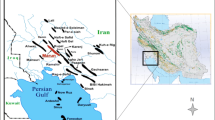Abstract
Reservoir characterization of petroleum reservoirs can be claimed as one of the most important parts of reservoir management for optimized production and future developments. Through reservoir evaluation, geological zoning for a better comprehension of subsurface structure is needed. For developing a model, porosity plays a vital role; there are two common methods for obtaining this parameter, core samples and well logging. However, the results of these methods are in well scale which cannot be used through field scale modeling. A solution can be the combining seismic field data well log data, which makes it possible to estimate the reservoir properties in field scale. In this study, multi-attribute analyses were applied based on multilayer perceptron to determine the reservoir facies alteration and heterogeneity in the Ghar reservoir of the Hendijan oil field located in the Persian Gulf. Facies modeling was done through the sequential indicator simulation (SIS) algorithm which coupled with the possible trend and indicator kriging (IK) as geostatistical methods. Within the comparison of these two generated models with core facies, the obtained accuracy of SIS algorithm coupled with the possible trend and indicator kriging are 94% and 72%, respectively. Porosity distribution was also done by the sequential Gaussian simulation (SGS) algorithm which resulted the average porosity of 18% in Ghar formation. The SIS method results are compatible with the porosity distribution model obtained from the SGS simulation. The final results prove the robustness of the applied methods for facies and porosity modeling.











Similar content being viewed by others
References
Amoyedo S, Atoyebi H, Bally J, Usman M, Nateganov A, Bergamo L et al (2016) Seismic-consistent reservoir facies modelling; a brown field example from deep water niger delta. Paper presented at the SPE Nigeria Annual International Conference and Exhibition
Bagheri M, Riahi MA (2017) Modeling the facies of reservoir using seismic data with missing attributes by dissimilarity based classification. J Earth Sci 28(4):703–708
Bagheri M, Riahi MA, Hashemi H (2013) Reservoir Lithofacies Analysis using 3D Seismic data in Dissimilarity Space. J Geophys Eng 10:9
Bagheri M, Riahi MA (2015) Seismic facies analysis from well logs based on supervised classification scheme with different machine learning techniques. Arabian J Geosci 8(9):7153–7161
Bohling G (2005) Stochastic simulation and reservoir modeling workflow. Australian J Basic Appl Sci 3:330–341
Chen F, Chen S Peng G (2012) Using sequential gaussian simulation to assess geochemical anomaly areas of lead element. Paper presented at the International Conference on Computer and Computing Technologies in Agriculture
Company P. P. Z. S. (2005) HENDIJAN Full Field Reservoir Study. Iranian Offshore Oil Co. I.O.O.C
Edalae A, Siahkohi HR (2007) Using seismic facies in the description of an Iranian oil reservoirs. Iranian Geophys J 1:37–49
Goovaerts P (1999) Geostatistics in soil science: state-of-the-art and perspectives. Geoderma 89(1–2):1–45
Goovaerts P, Webster R, Dubois J-P (1997) Assessing the risk of soil contamination in the Swiss Jura using indicator geostatistics. Environmen Ecolog Statist 4(1):49–64
Handhel AM (2009) Prediction of reservoir permeability from wire logs data using artificial neural networks. Iraqi J Sci 50(1):67–74
He Y, Chen D, Li B, Huang Y, Hu K, Li Y et al (2009) Sequential indicator simulation and indicator kriging estimation of 3-dimensional soil textures. Soil Res 47(6):622–631
Kamali MR, Omidvar A, Kazemzadeh E (2013) 3D geostatistical modeling and uncertainty analysis in a Carbonate reservoir, SW Iran. J Geolog Res
Kyi KK, Dan HX, Najm E, Poh CH (2014) Carbonate Reservoir Facies and Multi-Pore System Analysis Using LWD Resistivity Imager Acquired During Pressurised Mud Cap Drilling-A Case Study Offshore Sarawak, Malaysia. Paper presented at the SPE Asia Pacific Oil & Gas Conference and Exhibition
Marfurt KJ (2018) Seismic attributes as the framework for data integration throughout the oilfield life cycle: SEG Books
Moghanloo HG, Riahi MA, Bagheri M (2018) Application of simultaneous prestack inversion in reservoir facies identification. J Geophys Eng 15(4):1376
Remy N, BoucherA, Wu J (2009) Applied geostatistics with SGeMS: a user's guide: Cambridge University Press
Sarkar S, Banerjee S (2020) Facies, Paleogeography and Sequence Stratigraphy. In A Synthesis of Depositional Sequence of the Proterozoic Vindhyan Supergroup in Son Valley (pp. 31-104): Springer.
Wang J, Cao Y, Liu K, Liu J, Kashif M (2017) Identification of sedimentary-diagenetic facies and reservoir porosity and permeability prediction: An example from the Eocene beach-bar sandstone in the Dongying Depression, China. Marine Petroleum Geol 82:69–84
Zhang T-F, Tilke P, Dupont E, Zhu L-C, Liang L, Bailey W (2019) Generating geologically realistic 3D reservoir facies models using deep learning of sedimentary architecture with generative adversarial networks. Petroleum Sci 16(3):541–549
Acknowledgement
The authors are willing to appreciate the Institute of Geophysics, University of Tehran, and also Petroleum University of Technology for supporting this research.
Author information
Authors and Affiliations
Corresponding author
Additional information
Publisher's Note
Springer Nature remains neutral with regard to jurisdictional claims in published maps and institutional affiliations.
Rights and permissions
About this article
Cite this article
Zare, A., Bagheri, M. & Ebadi, M. Reservoir facies and porosity modeling using seismic data and well logs by geostatistical simulation in an oil field. Carbonates Evaporites 35, 65 (2020). https://doi.org/10.1007/s13146-020-00605-5
Accepted:
Published:
DOI: https://doi.org/10.1007/s13146-020-00605-5




